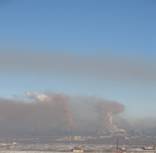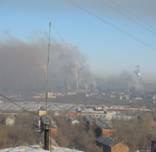The problem
Magnitogorsk in Western Russia lies on the banks of the Ural River. In the 1930's one of the largest Russian iron and steel works was established here that produced steel for half the Russian tanks during WW II. At optimum capacity it can produce up to 7.5 million tons of steel. The industry used to belch out 650,000 tons of industrial wastes, including 68 toxic chemicals, and polluted some 4,000 square miles of Russia. According to a steelworker, none of the filtering devices were in working condition.Health Impact
According to internet resources, the air pollution in this city is so bad that it is difficult to give birth to a live baby. The local hospital estimates that only 1% of all children in Magnitogorsk are in good health and increased cancer rates in the city are attributed to severe pollution from dioxides and benzopyrene. According to Nezavisimaya Gazeta, only 28% of infants born in 1992 were healthy, and only 27% had healthy mothers.Current Activity
This site was visited by Blacksmith Institute. Although health effects to the local population from the pollution are well-known, there was no concrete data available. Blacksmith Institute will fund health studies here and work with the plant towards further reducing pollution levels.
Russia



